Backed by Favorable Government Policies, Sales of Low Speed Electric Vehicles Set to Surge in Asia-Pacific in Future

With the increasing urbanization in the Asia-Pacific countries such as India and China, growing pollution levels, and the rising implementation of stringent environmental protection laws and policies, the deployment of low-speed electric vehicles (LSEVs) is increasing rapidly in the APAC region. Moreover, the governments of many APAC nations are providing huge support, in the form of various financial incentives such as grants, tax rebates, and subsidies for encouraging the usage of low-speed electric vehicles.
The governments of India and China are focusing on the complete electrification of public transport. For achieving this goal, they are providing heavy financial aid on the purchase of low-speed electric vehicles. For example, the Indian government is offering subsidies in the range of $370—$910 under the Faster Adoption and Manufacturing of (Hybrid &) Electric Vehicles (FAME) scheme. Furthermore, the environmental protection organizations are raising public awareness about the pollution caused due to the usage of the conventional vehicles.
Besides the aforementioned factors, the soaring expenditure on crude oil imports in several APAC nations is also positively impacting the sales of LSEVs in the region. In these countries, a major portion of the total crude oil imports is used by the public transport fleets. The adoption of low-speed electric vehicles is helping the governments of these countries considerably reduce their expenditure on crude oil imports. Additionally, the LSEVs have lower operational costs than the traditionally used electric vehicles.
As a result, a lot of people in the APAC countries are preferring these vehicles over the regular electric vehicles these days. Furthermore, the public transport fleet owners and authorities, especially in the developing countries, are focusing more on the long-term cost and environmental benefits, which is further boosting the deployment of LSEVs in the APAC region. Because of these reasons, the Asia-Pacific (APAC) low-speed electric vehicle (LSEV) market is predicted to register huge growth in the coming years.
The market is predicted to progress at a CAGR of 6.6% between 2018 and 2025 and reach a size of 71.8 million units in 2025. Depending on product, the APAC LSEV market is divided into four-wheeler, three-wheeler, and two-wheeler. Out of these, the two-wheeler category registered the highest growth in the market in the years gone by. This category is also predicted to record the highest growth in the market in the future years.
- Авто, мото
- Кейтеринг
- Досуг, развлечения
- Животные
- Красота, здоровье
- Образование, репетиторы
- Спорт и тренеры
- Строительство и ремонт
- Товары и магазины
- Туризм и отдых
- Финансы и страхование
- Литература
- Музыка
- История
- Политика
- Религия
- Искусство
- Кино
- Театр
- Хорошее здоровье
- Аксессуары
- Бизнес
- Разное


